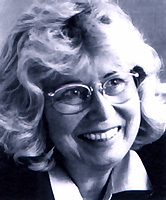|
CHARLOTTE KOLLMORGEN - OBSERVATIONS ON THE WORK OF A PAINTER
By Prof. Dr. Johannes Eucker, Hochschule der Künste, Berlin
Page 3
What does an artist in this day and age think of theories of colours, of chromatics? Have they promoted or determined her artistic practice? Charlotte Kollmorgen is aware of theories of colours, for example those by Hölzel and Itten. But she does not make conscious use of them. Quite deliberately she ostracised black from her work for a while, painting all shadows in colour, with the exception of just a few works that merely serve to prove the rule.
This gives many of the works dating from that period an impressionist lightness of touch creating the impression of brightness. Occasionally, she limits her palette, painting tone in tone. Primarily, though, her use of colour is vigorous, also full of contrast. But always there is a deliberate regulation and subordination of colour to an overall theme. Anything that may be construed as interference, as aggressive or destructive, is avoided.
The black pictures - from about 1991 onwards - came about in the context of the artist’s activity as a part-time lecturer in her Collage Therapy, an Art Therapy, which she created in 1981.
Adopting a completely different attitude from her other artistic activities she produces collages with her students reaching almost haphazardly for colourful and now also black image material. "The intellectual expert must be phased out in this process," she says. In this way she rediscovers black as an artistic design element, grapples with the colour black again, works her way through the diversity of shades of black in her compositions. - Since that time she has (again) embraced all colours.
It is especially in her small pictures with the centrally arranged circular shapes that a specific artistic attitude catches the eye. It is the delight in and the readiness for pictorial experimenting. In his work and in his book "Interaction of Colors" Josef Albers emphasised and demonstrated this experimental attitude of the modern artist. In her small size works Charlotte Kollmorgen uses water colours, but in quite an unspectacular way.
The themes and the titles of her pictures are not created simultaneously by the artist. Instead of themes one should perhaps rather seek to identify painting objectives (Kandinsky) in her works that are constituted in the "inner, expedient subordination" of the individual elements and the overall structure. Afterwards the artist then invents a title for the picture - often to assist the perception of the beholder.
The subjects of the pictures and/or the painting objectives have their roots in two areas. On the one hand they are based on things the artist has seen and experienced, things that can be named, like a trip to India or to Latvia. Logically, Charlotte Kollmorgen calls these pictures "Impressions", or "The Mysterious Portal", or even "Ganges". Other motifs emerge from the pre- or sub-conscious.
The draft of the picture already exists as a structure and a colour composition before the act of painting. The artist attributes this mode of work to her professional training as a graphic designer. She has a painting objective before her mind’s eye even before she begins to work. On the other hand, the details and variations of the idea are only produced and made tangible during the act of painting. They are condensed - in an inner, expedient way - into a recognisable painting objective that can also be described by approximation. Titles of paintings are "Bewegtes Blau" ( Blue in Motion), "Verdichtungen" (Condensing). Titles like "Entwicklungen in verschiedenen Richtungen" (Developments in Various Directions), "Fortgang" (Moving On), "Übergänge" (Transitions), "Wachsendes" (Growing), "Leben" (Life) and "Welterneuerung" (World Renewal) suggest notions of the processes of development and decline.
So, what has become visible in the creation process of her pictures? Kollmorgen’s paintings do not commit themselves, they do not commit the viewer, either. They are polyvalent, capable of being read, interpreted, evaluated differently by different beholders. Every viewer may quite possibly discover a different tendency: Is it the magnificent rather than the mundane, the special rather than the general, the religious rather than the secular, the public rather than the private, the central rather than the eccentric, the living rather than the dead, the rational rather than the mystic, the internal or the external?
|
|

